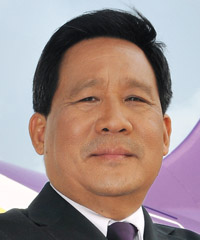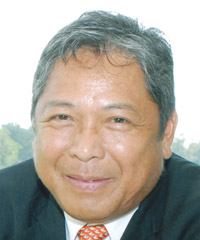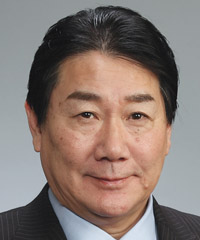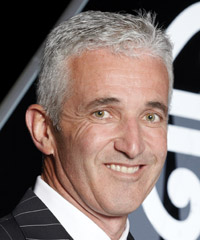Year End Review: People
Changing faces
December 1st 2012
Thai Airways International’s (THAI) former president, Piyasvasti Amranand, was unceremoniously sacked by his board last May. It took the industry by surprise, but maybe it shouldn’t have given the THAI board’s record for interference in the running of the airline and sacking of presidents. Read More »
 |
| THAI ex-boss, Piyasvasti Amranand: victim of politics? |
 |
| Ex-PAL president, Jaime Bautista: new broom swept in |
 |
| JAL CEO, Yoshiharu Ueki: a leading role of his own |
 |
| TransAsia chairman, Vincent Lin: inspirational |
 |
| Air NZ chief, Rob Fyfe: “world class” |
Piyasvasti had turned the carrier around from a record loss in the year before he arrived, to a profit. He also had gone a long way to stamping out endemic corruption and cronyism in the airline and won the respect of his peers throughout the industry.
Former energy minister Piyasvasti said the sacking was “politically influenced” and threatened legal action if his reputation was tarnished. He also suggested that some of the corrupt staff, who had been punished, may have sought help from powerful figures within government to oust him.
THAI chairman, Ampon Kittiampon, said the president had received an 86% approval rating in his performance evaluation, but had “communications problems with the board”.
“That’s ludicrous,” Piyasvasti told 750 delegates at the IATA annual general meeting in Beijing, when he sat on a chief executive panel and was asked about the sacking. “If I had communications problems, how could I push through all the changes in the airline, the financial capital increase, acquisition of 52 new aircraft, the biggest ever in THAI corporate history,” he said.
Political insider, Sorajak Kasemsuvan, who has no previous experience of the airline industry, was appointed president of the carrier by the THAI board in September. Acting president, Chokchai Panyayong, said in August that if THAI was not properly managed, its financial position could reach “crisis level” this year.
One chief executive who has had no problems with his board is Air New Zealand (Air NZ) boss, Rob Fyfe. He announced at the beginning of the year he was going to step aside “to encourage new talent” at the end of 2012. Fyfe was described as “world class” by Air NZ board chairman, John Palmer, after his announcement. Fyfe was the recipient of Orient Aviation’s Lifetime Achievement award this month, only the second time it has been awarded in 15 years (see separate story).
In June, head of long-haul operations, Christopher Luxon, was named as Fyfe’s successor.
Like Fyfe, until he joined Air NZ two years ago, New Zealand-born Luxon had not previously worked in aviation. He had held senior positions at Unilever in North America, Australia and Asia before returning to Auckland to join Air NZ. He has a hard act to follow.
In mid-year, one of the most respected and longest serving presidents, Jaime Bautista, stepped aside at Philippine Airlines (PAL). The move coincided with a new broom, the San Miguel Corporation, sweeping in at PAL and taking over the major shareholding and management from Lucio Tan.
Bautista was PAL’s chief financial officer when the carrier went into receivership with $2.1 billion of debt in 1998. He was a key player in formulating and implementing PAL’s 10-year rehabilitation plan.
Bautista became president in 2004 and relentlessly drove down costs and improved systems and productivity during his tenure at PAL. He led the airline out of rehabilitation two years ahead of schedule.
In the same year, PAL recorded the largest profit in its 66-year history. Bautista received Orient Aviation’s Person of the Year award in 2007. He is succeeded by Ramon Ang.
The re-born Japan Airlines (JAL) appointed former pilot, Yoshiharu Ueki, as its president in January. The son of one of Japan’s greatest movie actors, Chiezo Kataoka, he has been relishing his own leading role.
A JAL pilot for 35 years, Ueki often keeps a book of traditional Japanese philosophy in his pocket so he can read and learn when he has a spare moment. He must be hoping it will help him lead JAL back to its glory days. It has started well (see Overview, page 23).
Early this year self-confessed Asiaphile, Ray Conner, was in the region. He was here in his role as Boeing’s worldwide head of sales and customer support and spoke to Orient Aviation of his links with the Asia-Pacific that date back 25 years.
Three months later, in June, he was appointed president and chief executive of Boeing Commercial Airplanes.
Conner said he knew airlines like Singapore Airlines and Cathay Pacific Airways were going to be world leaders as far back as the early 1990s. “You could see it from their operations, from their product,” he said.
He also spoke of how Boeing could overtake Airbus to regain its lead in aircraft sales and deliveries. “We need more stability. Stability is about regaining our focus on the customers,” he said.
“Relationships are part of this business. People need to know you, need to trust you. Hopefully, my team and myself will be able to provide that stability.”
His remarks carry even more resonance now he heads Boeing’s commercial airplane division.
We called Vincent Lin inspirational in the April issue of Orient Aviation. The 39-year-old chairman of Taiwan’s TransAsia Airways has only been holding the reins of the carrier for two years, but in that time has re-invented it from a struggling player in the regional market to a profitable airline that is making its presence felt among its peer airlines.
TransAsia has been a major beneficiary of the booming Cross Straits airline market between Taiwan and Mainland China. The carrier flies to 17 cities in China, four of which were added this year. Last year, TransAsia carried 500,000 passengers between Taiwan and China, a five-fold increase over 2010.
The airline will double its fleet of 19 aircraft in the next five years. It took delivery of its first A330 at the end of November and has another on order among 31 aircraft due for delivery in coming years.
In this time, Lin is looking to extend his carrier’s reach to destinations in the Middle East, Australia and New Zealand.
TransAsia is not yet in the same league as national carrier, China Airlines, and EVA Air, but Lin compares his airline with Virgin Atlantic Airways. “They are giantkillers,” he said. “We are not quite giantkillers yet, but we are learning how to compete.”
In mid-year, Airen Omar was named as CEO and executive director of AirAsia Berhad, the Malaysian arm of the AirAsia Group. Omar had previously been head of corporate finance, treasury and investor relations at AirAsia.